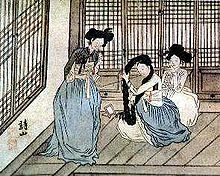
Back غساينغ Arabic Kisaeng Catalan Kiseng Czech Gisaeng German Kisaeng Spanish Kisaeng Basque گیسنگ Persian Gisaengit Finnish Kisaeng French Kiszeng Hungarian
| Kisaeng | |
 | |
| Korean name | |
|---|---|
| Hangul | 기생 |
| Hanja | |
| Revised Romanization | Gisaeng |
| McCune–Reischauer | Kisaeng |
 |
| Part of a series on the |
| Culture of Korea |
|---|
| Society |
| Arts and literature |
| Other |
| Symbols |
|
Kisaeng (Korean: 기생; RR: Gisaeng), also called ginyeo (기녀; 妓女), were enslaved women from outcast or enslaved families who were trained to be courtesans, providing artistic entertainment and conversation to men of upper class.[1][2][3] First appearing in Goryeo, kisaeng were the government's legal entertainers, required to perform various functions for the state. Many were employed at court, but they were also spread throughout the country. They were carefully trained and frequently accomplished in the fine arts, poetry, and prose, and although they were of low social class, they were respected as educated artists. Aside from entertainment, their roles included medical care and needlework.
Kisaeng play an important role in Korean conceptions of the traditional culture of the Joseon. Although the names of most real kisaeng have been forgotten, a few are remembered for an outstanding attribute, such as skill or loyalty. The most famous of these is the 16th century Hwang Jini.
- ^ Seth, Michael J. (2010). A History of Korea: From Antiquity to the Present. Rowman & Littlefield Publishers. p. 164. ISBN 978-0-7425-6717-7. Retrieved 8 February 2019.
- ^ "Life and role of gisaeng courtesans". The Korea Times. 2016-02-04. Retrieved 2016-10-27.
- ^ Lee Insuk. "Convention and Innovation: The Lives and Cultural Legacy of the Kisaeng in Colonial Korea (1910–1945)" (pdf). Seoul Journal of Korean Studies. 23 (1). Kyujanggak Institute for Korean Studies: 71–93. Retrieved 2016-10-27.
© MMXXIII Rich X Search. We shall prevail. All rights reserved. Rich X Search